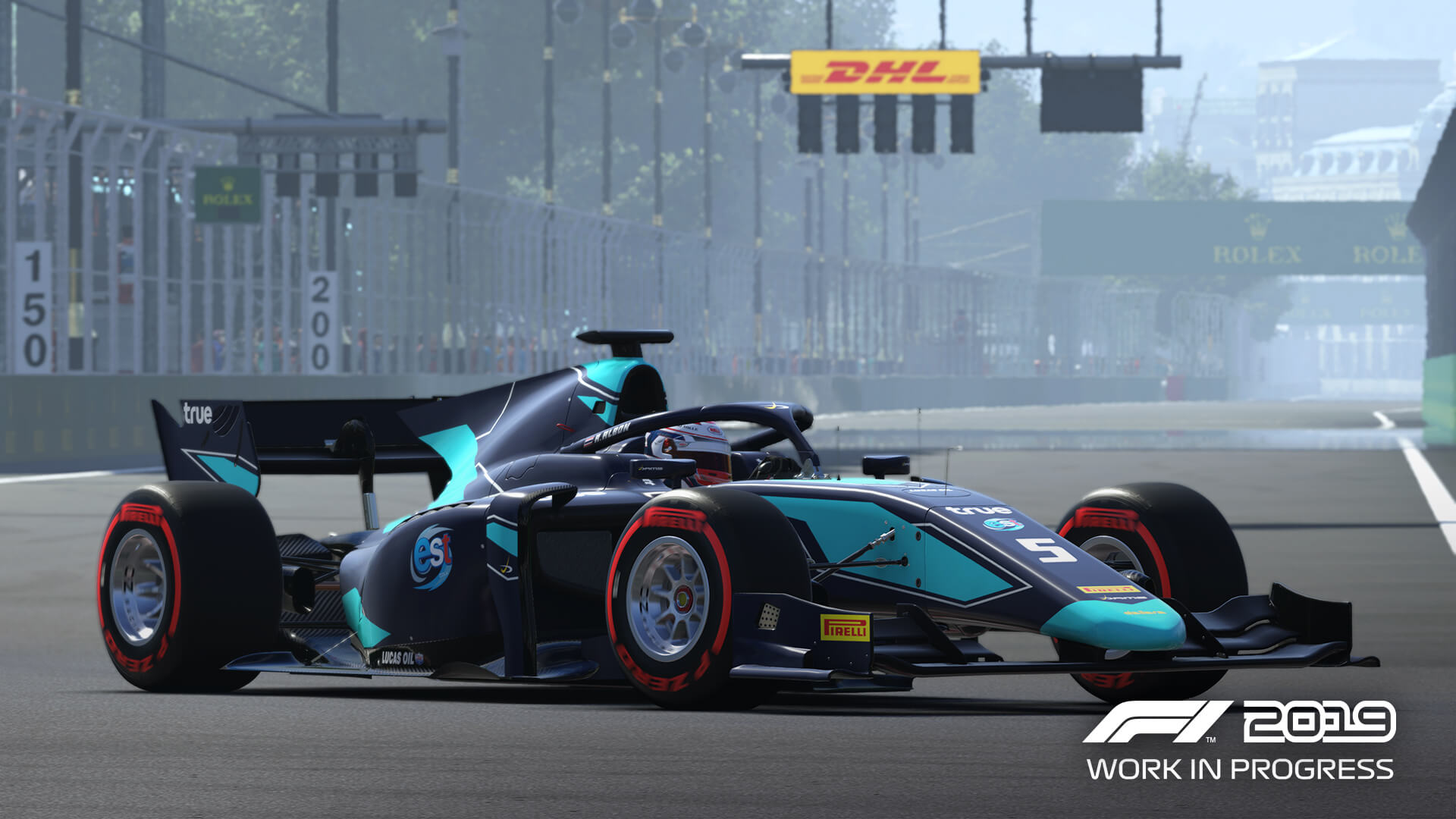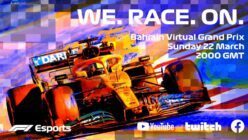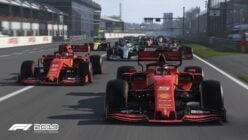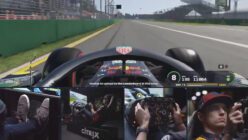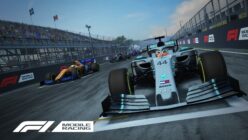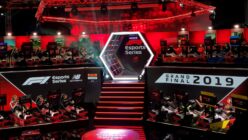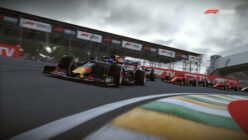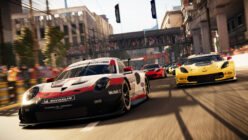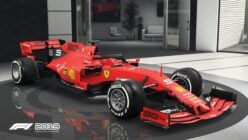I think after this weekend we can all agree on one thing: this F1 season is boring.
I’m not going to get bogged down in the reasons why. The important thing here is that the real-world circus has handed a golden opportunity to game developer Codemasters. Launching two months earlier than normal, F1 2019 continues the focus on esports while also cramming even more content into the single-player experience. It has the ability to be more interesting and engrossing than that which it’s based on.
Of course, that’s the million dollar question: is it? I’ve spent nearly a week digging into it to find out.
F1 2019 releases Friday, June 28, on PS4, XB1, and PC (or three days earlier for the Legends Edition). Codemasters provided a pre-release version of the game for review on PlayStation 4. I played it on PS4 Pro, with both a pad and the Fanatec CSL Elite PS4 wheel (with P1 Elite rim).
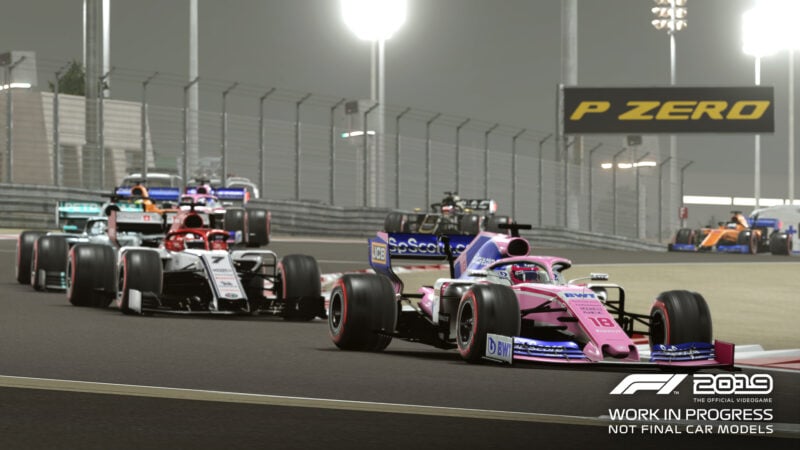
Content and Value For Money
It’s hard to ignore the biggest addition this year: Formula 2. The feeder series arrives wholesale, with all the teams, drivers, cars, and its unique rule set. It’s also all from 2018. Wait, what?
On first blush this seems like a missed opportunity. This is a 2019 game after all. But there’s two reasons this isn’t an early couple penalty points on F1 2019’s Super License. For starters, Codemasters has already stated it will be adding the 2019 season for free after release. But more importantly, it fits into the game’s crown jewel: the Career Mode.
This year, your digital avatar will begin in F2. It won’t be a full season, but rather a trio of highlight moments from races where your decisions will inform your F1 prospects. Signing up for certain driving academies earns you extra clout with specific pro squads — or you can go without one, with the freedom to pick any team, but face a steeper uphill battle to earn their respect.
The F2 appetizer introduces you to two fictional drivers mixing it with Albon, Russell, and the rest of the 2018 lineup. They both play firmly established stereotypes: the German “for the greater good” teammate, who values teamwork and order, and the vainglorious Brit sure he’s the greatest thing to happen to the sport since Fangio.
Storylines start here, with last year’s reporter Claire getting into the action too. Yes, you’ll be answering media questions again, with the same potential for team perks. But Claire’s smarter now, and she’ll ask questions with no clear benefit to you, only to revive the subject a few races later. It develops the narrative into a much more cohesive, wide-reaching arc, deepening what is already the most robust career mode in the genre.
When all three of you move onto the Big Show, you displace a trio of 2019 drivers. In my case of signing with Red Bull, that meant bye-bye Hulkenberg, Gasly and Bottas. The de facto villain of the story took the Silver Arrow spot, of course.
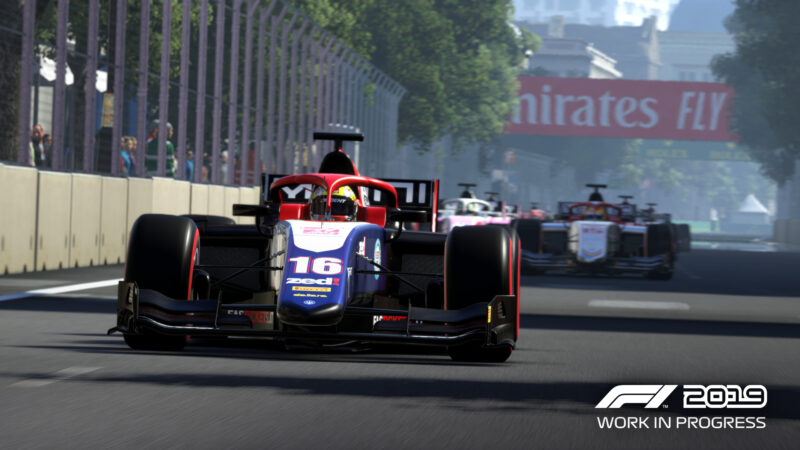
You’ll face off against these drivers during the regular season, plus the returning classic car invitational events that punctuate it. Your agent will also slip you news clippings of their own Claire interviews. But the cut scenes seemingly disappear after that initial amuse bouche, making the human drama of it all feel slightly half-baked. If you want to face off against as much of the real 2019 F1 grid as possible, you’re also left hoping that the ousted drivers return. Luckily, they can.
That’s right: drivers can now change teams, or leave and return to the sport. As luck would have it, during my initial run of the French Grand Prix, Hamilton got caught up in an accident and tumbled way down to 17th, where he stayed for the rest of the race. When contracts came up, Mercedes showed him the door, promoting Perez up from Racing Point, with Bottas taking the Mexican driver’s old seat. Harsh.
The rest of the F1 2019 career is largely similar to last year’s incredibly in-depth offering. You’ll negotiate contracts, help determine R&D focus — including when year-on-year regulation changes force redevelopment — and maneuver the tricky world of interviews. It might all seem overwhelming for an F1 novice, but the game explains everything quite clearly. Practice programs at every track train players on the layout, plus how to conserve tires and fuel. The granular difficulty settings make it all approachable for any skill level too.
Don’t want to deal with all the RPG elements? Championship mode gives you the straight goods: just show up and race. The full 2019 F1 and 2018 F2 seasons are here, plus curated series featuring modern and classic cars.
You’ll fight against some of the best AI in the business. The computer-controlled cars rarely scare when you get up in their space, offering fast and clean racing at all difficulty levels. They’ll move to defend if you’re coming up on their tail at the end of a straight. Or, if you’re surely going to pass them before the next turn, they’ll crowd you to the edge of the track, leaving just enough space to avoid contact. The life-like reactions from the AI makes single-player a blast instead of a bore.
The other major addition this year is a new spec Formula 1 car, designed for multiplayer. Its inclusion means selectable liveries for players, a move towards customization that’s reflected in the driver gear too. There isn’t the freedom of a true livery editor, but there are plenty of pre-made designs which players can then modify the colours of.
It’s the unlocking of these items that may prove contentious. F1 2019 introduces Competition Points, which are a secondary currency available through multiplayer. Many items are available for a set CP cost, and my testing showed the points are fairly easy to come across. However, there’s also “Premium” items, only available via real-cash purchases. At the time of writing these weren’t live on the PlayStation Store, but the pricing will largely dictate how the playerbase receives them.
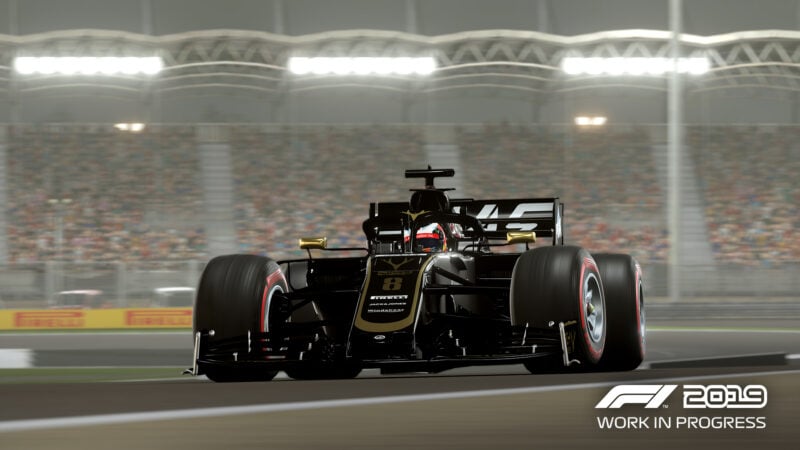
Online Features
That new spec car plays a big part in the revamped online modes. While all the other classes are still available to drive here, the spec car offers an honest, level playing field in the fastest stuff, so that races are all about driver skill. That also makes Leagues — new for this year — a lot easier to set up.
We’ve talked about it before, but Leagues are incredibly robust. The most impressive aspect is that scheduling can all be done in-game. You won’t have to herd cats elsewhere: just set a scheduled time and competitors will be able to find it easily in-game. You can also go the on-demand route if your league doesn’t have regular intervals.
The granularity is intense. Leagues can be public or private, and applications can either be automatic or require an admin or owner to approve it. Admins can hand down grid penalties and even edit results, though the latter is limited to private lobbies, likely to avoid utter chaos.
Amongst the options are AI drivers: not only can you choose to have them take part in a series, but you can choose whether they earn points or not. You can also set their difficulty, not just as the regular grid-fillers but also separately as the substitutes if a league member misses a a race or disconnects.
When players win a league, they’ll earn medals to display in their public trophy cabinet. Worry not, lovers of single-player: you too can display career trophies, though the process of claiming them via the in-game mail system is tedious.
The Super License returns with more information in F1 2019. Players’ skill ratings measure their ability to win races. The safety rating is self-explanatory, but word to the wise: tank it and you could receive penalties. The new attendance rating shows how reliable you are in the Leagues, while the driver level is how much wheel time you have.
It isn’t yet clear if players will be able to set League limits based on Super License stats, but it would make a lot of sense.
I took part in a handful of online races and it was smooth sailing. There were no jerky movements, even from players with seemingly awful connections. AI drivers don’t teleport around either.
There’s also a dedicated section in the main menu for the official F1 Esports series. Most of it simply takes you to the relevant page in the PS4 web browser, but nonetheless it’s an easy-access portal right there in the game.
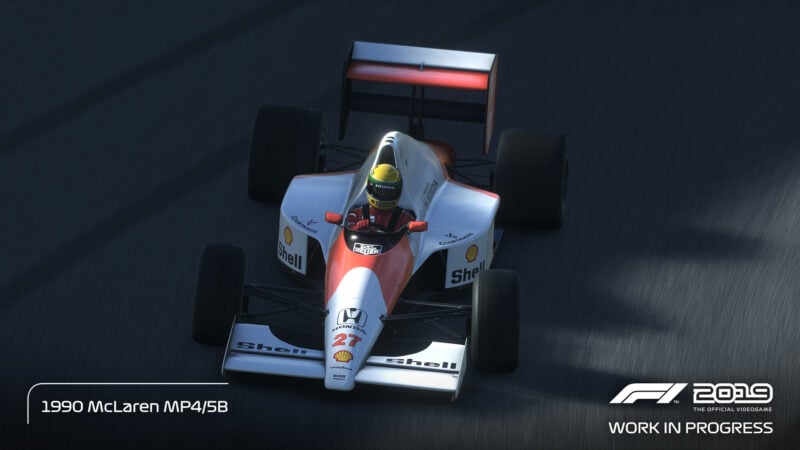
Driving Physics and Handling
If there’s a word for the F1 2019 physics, it’s “evolution”. Possibly prefaced with “mild”, if not for a few changes.
To my hands and feet, this feels much more like its predecessor than 18 felt of its. Back-to-back, there’s a bit more fluidity here, with the ’19 cars responding to inputs more accurately. It’s easier now to toe your way up to the edge of grip, especially at the front. It’s what happens past there where things have changed.
When I sat down with lead handling designer David Greco at a preview event, he talked about how the goal in 2019 was to more accurately model grip loss when past a tire’s peak. The drop-off is certainly noticeable here, as the front will plow on if you over-burden it. Taking the on-off approach to steering will utterly shred your tires too: smoothness is key, especially for those on pad.
The Dualshock is certainly a game partner, offering varying levels of rumble to give an idea of how the car is behaving. If you’re a tap-steerer, you may want to avoid the tire wear program during free practice, or learn light, steady inputs. The DS4 is also lacking the Xbox’s rumbly triggers, which makes threshold braking without ABS more of a muscle memory practice than one based on feedback.
Driving with the Fanatec feels natural. There’s a slug of self-centering torque that makes it easy to get a handle on the rear of the car, with clear feedback variations based on the different surfaces in the game. The load-cell pedal means I can brake with confidence, right up to the limit before lock-up. On stock settings both the F1 and F2 cars need an aggressive trail-braking approach to get their noses pointed in on corner entry.
It’s the feeder series car that proves the hardest to tame. Like its bigger brothers, the F2 car features a turbocharged V6. But with more displacement and a less advanced chassis, the torque will easily snap the rear end out from under unsuspecting drivers. Dial all the assists back and the learning curve is high. This is a simpler, more analog machine, and there’s joy to be had wringing the last bit of performance out of it.
The classics return again, and they also offer a breadth of experiences. Older cars, with their big engines and unrefined aero, require a patient right foot. They’re the comparative muscle cars of the game, meaning they’re lurid fun, if not the fastest way around the track. Cars from the V10 and V8 eras are sharper, though the grooved tires make them more hesitant on corner entry. On the flip-side, a comparative lack of torque makes something like the F2004 oddly easier to shoot out of corners.
Special mention also must go to the dynamic weather. Not only does it look great, but it has a serious effect on your drive. I stayed out on Mediums in a very light drizzle and felt the car slowly getting away from me. As the rain increases, switching to Intermediates, and then Full Wets, let the car bite into corners with more conviction. I kept them on too long however, and the moment the track could be considered dry, the grip fell off a cliff. This isn’t simple visual gimmickry.
https://phoenix.playwire.com/en/publishers/1021099/videos/5480545
Graphics
F1 2018 was a pretty solid looking racer. Codemasters hasn’t radically changed anything here, instead opting for detail work to bring the entire experience up a notch.
The quest for realism is no longer one involving sheer polygon power. No, it’s about lighting. The team’s let that principle guide it, and nowhere is this more noticeable than the night tracks. What used to be flat black nothingness now has depth, with lights diffusing and casting so many more reflections on the cars. The material work on the tires is also a big step up. That video above really did fool a fair amount of readers on our Facebook page…
If night time is a good way for a racing game to show off its visuals, so too is rain. When the clouds open up in F1 2019 it gets positively biblical. It looks great, with water clouding the camera and puddles forming all over the track. As the pack makes its way around, you’ll see the drying line appear too.
Plain ol’ sunny day time seems a little basic in comparison. I almost was wishing it’d rain more often.
I did experience two odd visual issues during my review period. One involved random single frames of what can only be described as “wild polygons” flashing up during a race in Monza. It happened only in a career race — not in any of the practice or qualifying either — and try as I might, I couldn’t replicate it.
The other, sadly, affected this review. It involved the Photo Mode. For whatever reason, at least on PS4, any attempt to change the shutter from the default freeze-frame 1/8000 results in a darkened shot. Maybe I’m doing it wrong. But it meant I couldn’t pepper all these words with some unique images. The settings changes do seem to apply, so I expect Codies will patch up the niggle soon.
Finally, a small but important change for consistency: the game now utilizes the official font (and on-screen graphics) of the real thing. It certainly helps lend it even more legitimacy, but the designer in me bemoans the lack of readability F1’s font offers at small sizes.
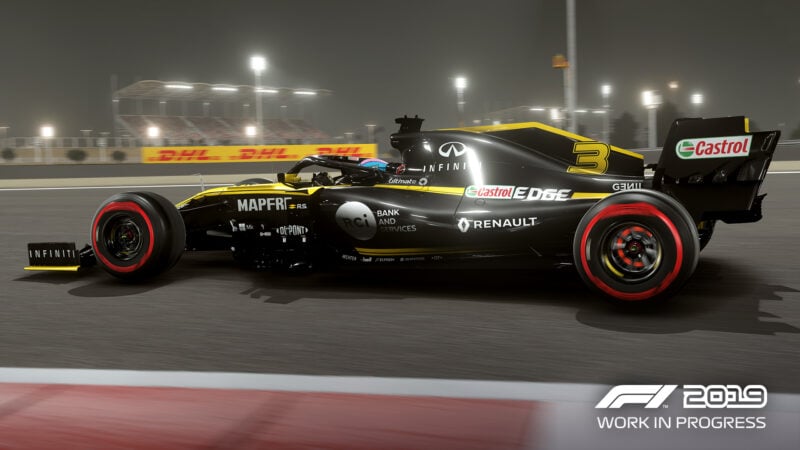
Sound Design
It can’t be overstated how much audio work exists in this game. There’s the cars of course, with the big-bore F2s sounding quite different in tone to the main acts, despite the identical cylinder count and aspiration. The classic cars cover a wide range too, from the animalistic oldest examples to the glass-shattering V10s and V8s.
Then there’s the transmission whine. Or the subtle change in the wind when the DRS flap levels out. It’s all well done.
It’s the voiceover work that really elevates the F1 titles though. David Croft and Anthony Davidson return for the big league, adding color to the on-track action. This year sees official F2 commentators Alex Jacques and Davide Valsecchi join the fray, and they’re just as good. Claire’s voice work is solid too, though her questions may get a little repetitive as the seasons wear on. One light brush with a wall is not “leaving bodywork out there”, Claire — go easy on me!
There’s not much I can say about this that I didn’t already say in last year’s review of F1 2018. Everything there still applies: play this game with headphones — maybe even Ferrari-branded ones — and enjoy.
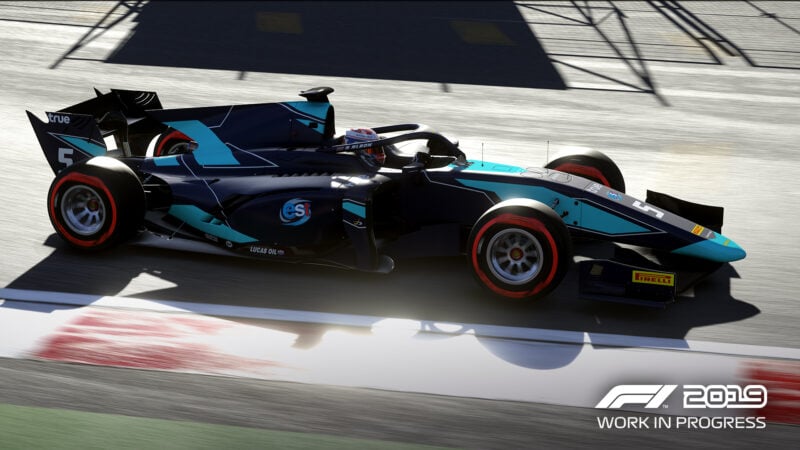
The Verdict
It should come as no surprise that F1 2019 feels very much like an evolution of what’s come before. That’s the nature of these annualized sports titles.
The important difference with F1 2019 is that it’s branching out. It’s improved on nearly every aspect of the previous title, while also introducing brand new content. F2 may seem more of the same — fairly high-powered open-wheelers — but a game with the focus of F1 2019 can highlight what makes them distinct. It also offers an obvious real-world parallel that few other racing games can match: a story.
The rise from F2 challenger to the ranks of F1 is a (relative) rags-to-riches tale just about anybody can identify with. That right there broadens the game’s appeal, and that it’s all wrapped up in a well-polished, accessible package is even better.
Don’t let the name fool you: F1 2019 is more than just the top shelf motorsport discipline. It’s also one of the most well-rounded, enjoyable titles in the genre.
F1 2019
Learn more about how our rating system works.

See more articles on Codemasters and Review.

